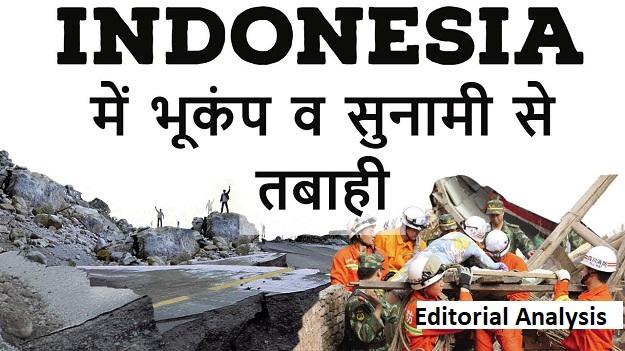Indonesia Earthquake Tsunami Disaster
First Earthquake then Tsunami.
INDONESIA DOUBLE SEMESTER
1407 lives have been lost in it more than 70,000 people have been displaced from their homes.
OPERATION SAMUDRA MAITRI
Indian Aircrafts C-130 & C-17 landed in Indonesia with the relief material along with this Three Indian Navy ships- INS Tir, INS Sujatha, and INS Shardul have also been carried out for
Humanitarian Assistance and Disaster Relief (HADR).
RING OF FIRE
Over 226,000 People have died due to the earthquake in the Ring Of Fire region in the last 10 years.
WHAT HAPPENED(2018)
After a significant 7.5 – magnitude earthquake, Tsunami hit Palu, a city in the Indonesian Island Of Sulawesi.
WHAT CAUSED THE 2004 TSUNAMI?
The epicenter of the 9.0 magnitude quake was located in the Indian Ocean near the west coast of Sumatra.
The violent movement of the Earth’s tectonic plates displaced an enormous amount of water, sending powerful shock waves in every direction.
This kind of sizeable vertical displacement happened because the magnitude of the earthquake was more significant than 9 and it occurred at a shallow depth of less than 30km below the ocean.
Vertical earthquakes – Catastrophic tsunamis are often triggered by ‘megathrust earthquakes’.
These occur at subduction zones when one tectonic plate is forced under another.
It causes massive chunks of the earth’s crust to move vertically.
Such movements on the ocean’s floor cause vast volumes of water to be displaced suddenly.
They thus throw up giant waves that can travel very fast across vast distances.
E.g. the December 2004 Indian Ocean tsunami.
It had waves up to 100 ft high which was triggered by a megathrust earthquake of 9.1-magnitude in Sumatra.
The tsunami resulted in at least 227,898 fatalities.
WHAT IS THE PRESENT INDONESIA CASE?
Horizontal earthquake
Indonesia experiences earthquakes every day, but the scale of the quake and tsunami which hit Palu took local people and scientists by surprise.
More than 1,000 people have died, but the final figure could be much higher.
That’s because the two plates are moving horizontally, not with the vertical thrust usually required to set off dangerous waves.
“We have been trying to figure out what was going on,” says Prof Liu.
It could be that the quake kicked off a landslide underwater, which in turn disturbed the water, he says, or there could be inaccuracies in describing the fault, but “we don’t know yet”.
‘Horizontal’ earthquakes – The recent 7.5-magnitude quake in Indonesia was triggered by what is called a ‘strike-slip fault’.
In this type of quake, the earth’s movement is mostly horizontal which would not usually trigger a tsunami.
However, it is possible for a strike-slip fault to also have some amount of vertical motion that could displace water.
Or the fault’s rupture zone may pass through an area where the seafloor rises or drops off.
In such cases, when the fault moves during the quake, it pushes seawater in front of it.
Notably, in Indonesia’s case, the fault’s rupture zone was estimated to be about 70 miles long, suggesting a significant possibility for the above.






















 WhatsApp
WhatsApp